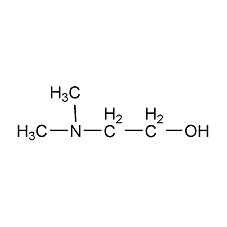2-Dimethylethanolamine 2-Dimethylaminoethanol


Structural formula
| Business number | 02W8 |
|---|---|
| Molecular formula | C4H11NO |
| Molecular weight | 89.14 |
| label |
2-(dimethylamino)ethanol, 2-Dimethylaminoethanol, N,N-dimethyl-2-hydroxyethylamine, 2-Hydroxyethyldimethylamine, N,N-Dimethylethanolamine, N,N-Dimethyl-2-hydroxyethylamine, 2-(Dimethylamino)ethanol, (CH3)2NCH2CH2OH, Epoxy resin hardener, Multifunctional solvent |
Numbering system
CAS number:108-01-0
MDL number:MFCD00002846
EINECS number:203-542-8
RTECS number:KK6125000
BRN number:1209235
PubChem number:24864369
Physical property data
1. Properties: Colorless and volatile liquid with ammonia smell. [1]
2. Melting point (℃): -59.0[2]
3. Boiling point (℃): 134.6[3]
4. Relative density (water=1): 0.89 (20℃)[4]
5. Relative vapor density (air = 1): 3.03[5]
6. Saturated vapor pressure (kPa): 0.612 (20℃)[6]
7. Octanol/water partition coefficient: -0.940[7]
8. Flash point (℃): 40.5 (OC) [8]
9. Ignition temperature (℃): 295[9]
10. Explosion limit (% ): 11.9[10]
11. Lower explosion limit (%): 1.6[11]
12. Solubility : Miscible with water, miscible with ether, acetone and aromatic hydrocarbons. [12]
Toxicological data
1. Skin/eye irritation
Open irritation test: rabbit, skin contact: 445mg, severity of reaction: mild.
2. Acute toxicity: Rat oral LD50: 2340mg/kg; rat inhalation LC50: 1641ppm/4H; rat abdominal LD50: 1080mg/kg; mouse inhalation LC50: 3250mg/ m3; mouse intraperitoneal LD50: 234mg/kg; mouse subcutaneous LD50: 961mg/kg; rabbit dermal LD50: 1370μL/kg; guinea pig intraperitoneal LDLo: 450mg/kg;
3. Other multiple dose toxicity: TCLo by inhalation in rats: 670mg/m3/4H/22W-I; TCLo by inhalation in rats: 288ppm/6H/2W-I ; Rat inhaled TCLo: 76ppm/6H/13W-I;
4. Acute toxicity [13] LD50: 2340mg/kg (large Rat oral); 1370mg/kg (rabbit transdermal)
5. Irritation[14]
Rabbit Transdermal: 445mg, mild irritation (open irritation test)
Rabbit eye: 5μl, severe irritation.
Ecological data
1. Ecotoxicity No data available
2. Biodegradability No data available
3 .Non-biodegradabilityN/AMaterials
4. Other harmful effects [15] This substance is harmful to the environment, and special attention should be paid to the pollution of water bodies.
Molecular structure data
1. Molar refractive index: 25.83
2. Molar volume (cm3/mol): 99.3
3. Isotonic specific volume (90.2K ): 233.7
4. Surface tension (dyne/cm): 30.6
5. Dielectric constant:
6. Dipole moment (10-24cm3):
7. Polarizability: 10.24
Compute chemical data
1. Reference value for hydrophobic parameter calculation (XlogP): -0.4
2. Number of hydrogen bond donors: 1
3. Number of hydrogen bond acceptors: 2
p>
4. Number of rotatable chemical bonds: 2
5. Number of tautomers: none
6. Topological molecule polar surface area 23.5
7. Number of heavy atoms: 6
8. Surface charge: 0
9. Complexity: 28.7
10. Number of isotope atoms: 0
11. Determine the number of atomic stereocenters: 0
12. Uncertain number of atomic stereocenters: 0
13. Determine the number of chemical bond stereocenters: 0
14. Number of uncertain chemical bond stereocenters: 0
15. Number of covalent bond units: 1
Properties and stability
1. Chemical properties: similar to 2-(diethylamino)ethanol. It can generate hexachloroplatinate 2C4H11NO·H2PtCl6 (melting point 178℃), perchlorate C4H11NO·HClO4 (melting point 400℃), and tetrachloroaurate C4H11NO·HAuCl4 (melting point 194℃).
2. This product has low toxicity. It has a stimulating effect on the skin and central nervous system. Therefore, protective measures should still be taken according to the “Toxic Chemical Regulations”.
3. Stability[16] Stable
4. Incompatible substances[17] Strong oxidants, acids, copper, zinc and their alloys
5. Polymerization hazard[18] No polymerization
Storage method
1. Storage precautions[19] Store in a cool, ventilated warehouse. Keep away from fire and heat sources. The storage temperature should not exceed 37°C. Keep container tightly sealed. They should be stored separately from oxidants, acids, metal powders, etc., and avoid mixed storage. Use explosion-proof lighting and ventilation facilities. It is prohibited to use mechanical equipment and tools that are prone to sparks. The storage area should be equipped with emergency release equipment and suitable containment materials.
2. Packed in tin barrels, with a net weight of 180kg per barrel. Store in a cool and ventilated place, and store and transport according to regulations on flammable and toxic chemicals.
Synthesis method
1. Ethylene oxide method: It is obtained by ammoniation of dimethylamine and ethylene oxide, followed by distillation, rectification and dehydration.
![]()
2. Chloroethanol method By chlorine Ethanol is saponified with alkali to generate ethylene oxide, which is then synthesized with dimethylamine to obtain dimethylaminoethanol. Industrial product dimethylaminoethanol, purity ≥95%. Raw material consumption quota: chloroethanol (32%) 5500kg/t, dimethylamine (40%) 2200kg/t. During production, chloroethanol can also be added dropwise directly to dimethylamine, with a yield of 85%.

Refining method: normal pressure or reduced Refined by pressure distillation.
Purpose
1. Used as a raw material for resins, medicines, dyes and paint solvents. Used as an intermediate and epoxy resin curing agent in the manufacture of dyes, fiber treatment agents, pharmaceuticals, anti-corrosion additives, etc.
2. Used as a raw material for resins, medicines, dyes and paint solvents. [20]
